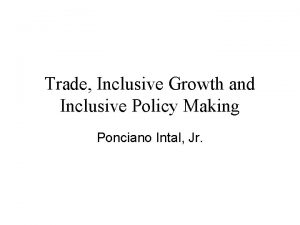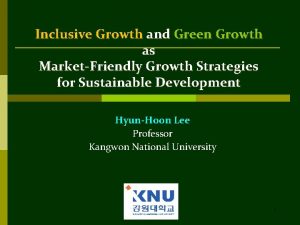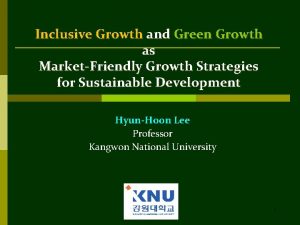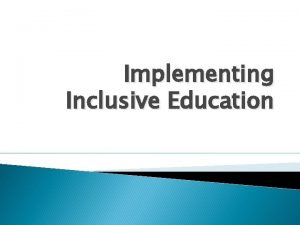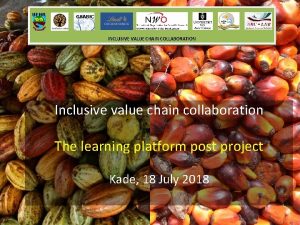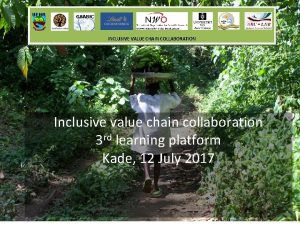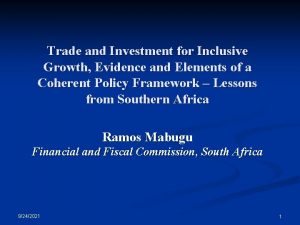Trade and Inclusive Growth Mechanism for More Inclusive














- Slides: 14

Trade and Inclusive Growth : Mechanism for More Inclusive Policy Making Dr. Posh Raj Pandey South Asia Watch on Trade Economics and Environment (SAWTEE), Kathmandu, Nepal

Structure of presentation • Trade and Growth : theory and empirics • Making Inclusive Growth-Friendly Trade: – Policies – Institutions • Tentative Agenda

Sources of Growth and the Role of Trade Growth results from three sources • Growth in inputs of production (factor accumulation) • Improvements in the efficiency of allocation of inputs across economic activities • Innovation that creates new use for existing products or brings about more efficient use of inputs Trade contributes to each of the three sources through • Static efficiency gains associated with improved resource allocation for national economies as well as for the world economy due to increased specialization • Dynamic efficiency gains from such factors as economies of scale, diffusion of information, technology transfer, knowledge spillover effects and consumption and investment smoothing Also reinforcing relationship : higher growth spurs large volume of trade flows.

Trade and Growth Process Trade is good for growth and growth is good for trade (Dollar and Kaary 2000) But it can produce winners and losers and can widen inequality within and among countries because of • Change in relative product and factor prices • Differential cross border factor mobility and associated change in global market and power structures • The nature of technical progress and the technological diffusion process • Differential impact on information flow • Differential impact on volatility and vulnerability • Difference in the role of institutions in mediating transmission mechanism The challenge is to create more winners, i. e. making growth more inclusive.

Conceptualizing Inclusive Growth ‘Growth is inclusive when it allows all members of a society to participate in, and contribute to, the growth process on an equal basis regardless of their individual circumstances’ -Asian Development Bank Inclusive economic growth can be achieved by focusing on expanding the regional scope of economic growth, expanding access to assets and thriving markets and expanding equity in opportunities for the next generation no matter who they are or where they are. ‘ - World Bank Inclusive growth is a process and outcome where all groups of people have participated the outcome where all groups have participated in the organization of growth and have benefited equitably from it. ’ - United Nations Development Programme (UNDP)

Conceptualizing Inclusive Growth (contd. . ) Consensus emerges on the outcome of inclusive growth as: • Sustainable and equitable growth: broad-based across sectors and regions, and inclusive of the large part of the labour force, including the poor and vulnerable groups of the population • Social inclusion : removal of the institutional barriers and the enhancement of incentives to increase the access of all segments of the society to development opportunities • Empowerment : enhancement of the assets and capabilities of diverse individuals and groups to function in and to participate in the growth process • Security : improved management of the social risk arising of development intervention

Trade Impacts Inclusive Growth Process • Expenditure effects : change in the price of goods • Income and employment effect : change in the remuneration of factor of production • Effects on changes in tariff revenue and taxes: provision of public goods such as health, education and socio-economic security system Properly crafted trade policy and its instruments, both in terms of content and the process, would help inclusive growth friendly trading system.

Trade Policy Process Povertydevelopment reduction strategy National strategy Trade strategy Support from multilateral and bilateral Private donors In-country trade Government ministries Prioritized trade-related capacity building needs Civil society, Academia, research policy sector formulation Effective participation in international trade negotiations Increasing trade and investment Achievement of poverty reduction objectives Achieve trade objectives Achievements of development objectives Source: UNCTAD

Trade Policy Making : Some Problems in Developing Countries • Poor leadership • Weak institutions: absence of effective trade data collection and analysis, weak information system, lack of technical knowledge and skills in trade policy analysis • Lack of coordination • Lack of consultation: private sector, civil society organizations, research institutions • Weak participation in multilateral forum

Inclusive Trade Policies : actions at national level • Integration of trade policy into overall development goals and strategies • Export led growth strategy with human face • A balanced growth strategy based on agriculture growth and export-led industrialization • Promotion of employment-intensive economic activities and technology changes • Market creation, market development, market acceleration and promotion of competition culture • Creating synergies through the global value-chain • Investing in productive capacity and trade logistics • Provisioning for public goods and trade related adjustment cost

Inclusive Trade Policies: actions at international / multilateral level Market access : tariff, non-tariff measures (NTM), Mode 4 South-South cooperation and/or regional trading arrangement Innovative, but responsible financial mechanism Addressing food security, livelihood, bio-diversity, climate change and environmental concerns • Making aid more inclusive and productive • Meaningful participation in multilateral decision making process • •

Inclusive Trade Policies : empowering people • • Agenda setting Policy formulation Implementation, and Evaluation

Inclusive trade policy: a tentative agenda • Assessment of the extent of integration of trade policy into development strategies • Assessment of backward linkages of export sector • Assessment of Mode 4 liberalization on inclusive growth • Assessment of the trade impact on food security, livelihood, biodiversity, climate change and environment concerns • Strengthening trade policy institutions • Exploration of the mechanism for engaging stakeholders in all policy making process • Effective leadership and participation in multilateral forum • Identifying the use of foreign aid

Thanks you for your kind attention.
 Lirik lagu more more more we praise you
Lirik lagu more more more we praise you More more more i want more more more more we praise you
More more more i want more more more more we praise you What can we do to make worship more inclusive for all
What can we do to make worship more inclusive for all Trade diversion and trade creation
Trade diversion and trade creation Umich
Umich Trade diversion and trade creation
Trade diversion and trade creation Trade diversion and trade creation
Trade diversion and trade creation Tramp chartering
Tramp chartering Plant growth analysis
Plant growth analysis Monocots vs eudicots
Monocots vs eudicots Primary growth and secondary growth in plants
Primary growth and secondary growth in plants Primary growth and secondary growth in plants
Primary growth and secondary growth in plants The trade in the trade-to-gdp ratio
The trade in the trade-to-gdp ratio Fair trade not free trade
Fair trade not free trade Ted talk slave trade
Ted talk slave trade
















